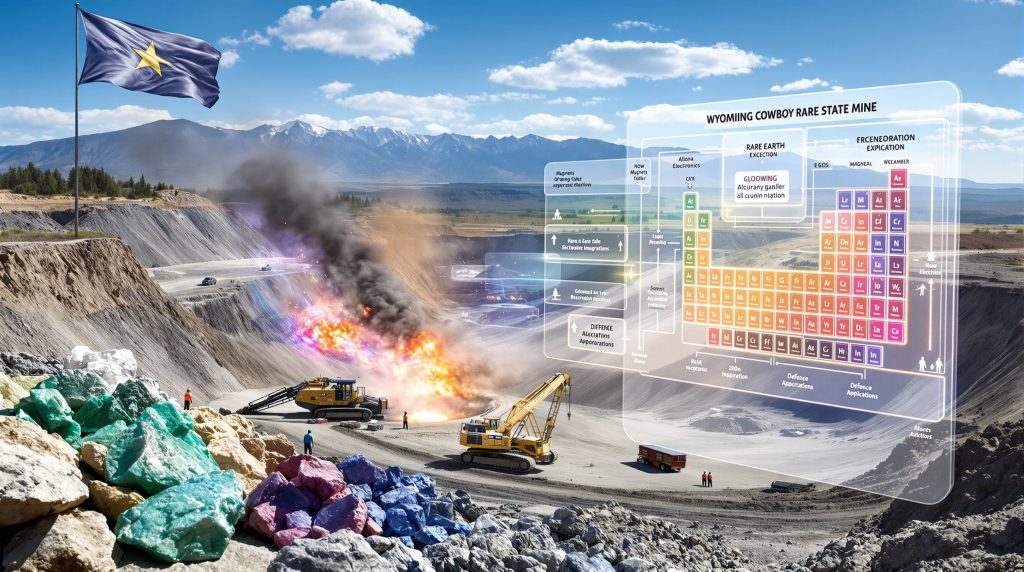Understanding Test Mining at Cowboy State Mine: A Pivotal Moment for US Rare Earths
Test mining has officially begun at the Cowboy State Mine, marking a significant milestone in American Rare Earths' Halleck Creek project in Wyoming. This development represents more than just routine mineral extraction—it's a strategic step toward establishing domestic rare earth supply chains and reducing US dependency on foreign imports. But what exactly does test mining entail, and why should investors, industry observers, and Americans concerned about supply chain security take notice?
Understanding American Rare Earths' Wyoming Project
The Strategic Location of Halleck Creek
The Halleck Creek rare earth deposit sits on Wyoming state land, a location that offers considerable advantages beyond its rich mineral potential. Situated in a mining-friendly jurisdiction with established infrastructure, the project benefits from Wyoming's long history of resource development and supportive regulatory framework.
Wyoming's central location in the western United States provides logistical advantages for future distribution across North America, with rail connections and highway access that can facilitate movement of materials to processing facilities or end users. The state's existing mining workforce and educational institutions focused on resource extraction further enhance the project's viability.
Cowboy State Mine's Position in the US Rare Earth Supply Chain
Cowboy State Mine represents a potential cornerstone in rebuilding America's rare earth element (REE) capabilities. Currently, the United States relies heavily on imports for these materials, with China dominating global production at approximately 85% of worldwide supply. This dependency creates vulnerability for key industries including defense, renewable energy, and high-tech manufacturing.
What sets Cowboy State Mine apart is not just the presence of rare earth elements, but the potential scale and composition of the deposit. Initial assessments suggest it contains significant quantities of neodymium, praseodymium, and other critical minerals energy transition elements crucial for permanent magnets used in electric vehicles, wind turbines, and military applications.
The test mining operation will extract approximately 3,200 tonnes of ore—a relatively small amount that will provide crucial data for future development decisions while minimizing environmental impacts during this exploratory phase.
Regulatory Advantages of Wyoming State Land
One of the most significant advantages of the Halleck Creek project is its location on Wyoming state land rather than federal property. This distinction creates a streamlined permitting process that can significantly reduce development timelines.
Wyoming's regulatory framework for mining on state lands typically features:
- Faster permitting processes compared to federal land projects
- Consolidated oversight under state agencies rather than multiple federal bureaus
- Clear reclamation requirements and environmental standards
- Predictable fee and royalty structures
The company is currently operating under a State of Wyoming License to Explore by Dozing, which allows for the limited extraction needed for test mining while maintaining appropriate environmental controls.
How Does the Test Mining Process Work?
Blasting and Excavation Methodology
The test mining at Cowboy State Mine employs a carefully planned two-phase approach to material extraction. The first phase targets weathered surface material, which has already been fractured to a depth of approximately 3.6 meters in the initial blast. This weathered zone typically contains ore that has been naturally broken down by environmental exposure over time.
The blasting process utilizes precision drilling and carefully calculated explosive charges to minimize disturbance while effectively fracturing the target material. Engineers monitor seismic activity during blasts to ensure vibrations remain within safe parameters and to gather data on rock fragmentation patterns.
For the second phase, workers will focus on non-weathered material that requires different handling techniques due to its greater density and structural integrity. This dual approach allows the company to compare processing requirements for different material types from the same deposit.
Weathered vs. Non-Weathered Material Processing
The distinction between weathered and non-weathered material is crucial in rare earth mining for several reasons:
- Mineralogical differences: Weathered material often has different mineral associations and chemical compositions compared to fresh rock
- Processing implications: Each material type may require different crushing, grinding, and separation techniques
- Recovery rates: Extraction efficiency can vary significantly between weathered and non-weathered ore
- Economic considerations: Processing costs can differ substantially based on material characteristics
By testing both types of material, engineers can develop optimized processing methods for each and determine the most cost-effective approach for future commercial operations. This dual-stream testing represents industry best practice for thorough deposit characterization.
Crushing and Stockpiling Procedures
After extraction, the non-weathered ore undergoes a controlled crushing process to reduce the material to pieces approximately 5 centimeters in size. This size reduction is carefully calibrated to:
- Facilitate efficient materials handling
- Prepare samples for laboratory analysis
- Create appropriately sized feed material for pilot processing tests
- Maintain mineral integrity for accurate metallurgical assessment
The crushed material is then systematically stockpiled according to its origin location and characteristics. This methodical approach ensures sample integrity and traceability throughout the testing process, allowing engineers to correlate processing results with specific zones within the deposit.
Each stockpile is carefully documented with:
- Precise location coordinates of the source material
- Geological characteristics and visible mineralization
- Date of extraction and processing
- Preliminary grade estimates from field testing
This meticulous record-keeping creates a valuable database that will inform future modern mine planning decisions if the project advances to commercial production.
What Will the Extracted Ore Be Used For?
Metallurgical Testing and Process Optimization
The primary purpose of the test mining operation is to provide substantial material for comprehensive metallurgical testing. Unlike small drill core samples, these larger volumes allow for more representative testing that can:
- Validate bench-scale results at a larger scale
- Test multiple processing variables simultaneously
- Identify potential challenges in material handling and processing
- Optimize reagent consumption and recovery rates
- Assess variability across different portions of the deposit
Metallurgical testing will examine various extraction methods, including conventional acid leaching and potentially more environmentally friendly alternatives. Engineers will evaluate each approach based on recovery rates, reagent consumption, processing time, and environmental considerations.
Building Feedstock for the Demonstration Plant
A significant portion of the extracted material will be allocated for a planned demonstration plant. This intermediate step between laboratory testing and commercial production will process material at a scale sufficient to:
- Validate processing flowsheets in continuous rather than batch operation
- Identify and resolve scaling issues that don't appear in laboratory tests
- Train operators on the specific requirements of Halleck Creek material
- Produce larger samples of rare earth concentrates for further refinement testing
- Generate operating data for financial modeling and investment decisions
The demonstration plant represents a critical de-risking step, providing valuable data while requiring significantly less capital investment than a full commercial facility.
Creating Samples for Potential Partners
The test mining will also yield material for producing samples for potential offtake partners and strategic investors. These samples serve multiple purposes:
- Allow potential customers to verify material compatibility with their processes
- Demonstrate product quality and consistency
- Support detailed discussions about specifications and pricing
- Build confidence in the project's technical viability
- Facilitate earlier engagement in the supply chain development
By providing tangible samples rather than just analytical results, American Rare Earths begins test mining at Cowboy State Mine to engage more effectively with potential partners across the rare earth value chain, from separation facilities to end users in manufacturing.
Why is Test Mining a Critical Milestone?
De-Risking Future Development
Test mining represents a crucial de-risking step in the overall project development. By extracting and processing actual material at scale, the company can identify and address potential challenges before committing to full-scale development capital. This approach helps to:
- Validate geological models with bulk samples rather than just drill cores
- Identify any unexpected mineralization or material handling challenges
- Test equipment suitability for the specific characteristics of Halleck Creek ore
- Refine capital and operating cost estimates based on actual field experience
This methodical approach to de-risking aligns with industry best practices for responsible resource development and provides greater confidence to potential investors and partners.
Validating Processing Flowsheets at Scale
Laboratory test work typically uses small samples that may not fully represent the variability within a deposit. Test mining provides substantial material for validating processing approaches across a range of conditions:
- Different ore zones and material types
- Various crush sizes and liberation characteristics
- Alternative reagent mixtures and concentrations
- Different equipment configurations and processing parameters
This comprehensive testing helps engineers develop robust processing methods that can accommodate the natural variability that exists within any mineral deposit, leading to more reliable performance in commercial operations.
Generating Operational Data for Mine Planning
The test mining operation yields valuable data that extends beyond laboratory results to include practical operational insights:
- Equipment productivity in the specific geological conditions
- Labor requirements for various activities
- Consumable usage rates under field conditions
- Material handling characteristics from pit to processing
- Actual versus theoretical fragmentation patterns from blasting
This operational data helps refine economic models and mine planning assumptions, leading to more accurate feasibility studies and investment decisions. It also provides early identification of any specialized equipment or techniques that might be required for full-scale operations.
Supporting Commercial Discussions with Partners
With tangible results from test mining, commercial discussions move from theoretical to practical. Potential partners and investors can evaluate:
- Actual recovery rates rather than projected estimates
- Real processing costs based on field experience
- Product specifications from larger-scale samples
- Operational challenges and mitigation strategies
- Environmental performance under field conditions
These evidence-based discussions typically lead to more realistic commercial arrangements and stronger partnerships than those based solely on laboratory projections and feasibility studies.
What Makes Halleck Creek Significant to US Rare Earth Supply?
Scale and Resource Potential
Halleck Creek stands out among American rare earth projects for its sheer scale. While specific resource estimates continue to be refined, initial assessments suggest it represents one of the largest rare earth resources in the United States. This scale matters for several reasons:
- Potential for long mine life (potentially decades) that justifies investment in processing infrastructure
- Possibility of higher production rates that could significantly impact domestic supply
- Economic advantages from economies of scale in mining and processing
- Strategic significance as a substantial domestic source of critical materials
The deposit's rare earth mineralogy is also noteworthy, with preliminary work indicating favorable distribution of the most commercially valuable rare earth elements, particularly those used in permanent magnets.
Cost-Efficient Open-Pit Mining Possibilities
The near-surface nature of the Halleck Creek deposit presents opportunities for cost-efficient open-pit mining methods rather than more expensive underground operations. This approach offers several advantages:
- Lower operating costs per tonne of material moved
- Higher production rates with standard mining equipment
- Reduced technical complexity and associated risks
- Better recovery rates with less selective mining requirements
- More flexible operations that can adapt to market conditions
These economic advantages could potentially position Halleck Creek as a lower-cost producer compared to more geologically complex rare earth deposits, enhancing its competitiveness in global markets.
Reduced Reliance on Foreign Imports
The United States currently imports approximately 80% of its rare earth needs, creating strategic vulnerabilities across multiple industries. Halleck Creek's development could substantially reduce this dependency by:
- Providing a secure domestic source for critical materials
- Shortening supply chains for US manufacturers
- Reducing exposure to foreign trade policies and export restrictions
- Creating greater price stability for downstream industries
- Supporting the reshoring of manufacturing that requires rare earth inputs
This reduction in import reliance aligns with broader national security objectives and industrial policy goals focused on supply chain resilience, particularly in the context of ongoing US-China trade war impacts.
Strategic Materials for Defense and Technology
The specific rare earth elements found at Halleck Creek have particular significance for defense and high-technology applications:
- Neodymium and praseodymium for permanent magnets used in precision-guided munitions
- Dysprosium for maintaining magnet performance at high temperatures
- Terbium for magneto-optical materials and solid-state devices
- Various rare earths for radar systems, communications equipment, and night vision technology
These applications represent areas where supply disruptions could have significant national security implications, making domestic production particularly valuable beyond purely economic considerations. Many countries are now developing a critical minerals strategic reserve to address these concerns.
What Environmental Considerations Are Being Addressed?
Backfilling Practices for Weathered Material
The test mining plan includes specific provisions for responsible site management, including backfilling excavated areas with weathered material after testing is complete. This approach:
- Minimizes the physical footprint of the test mining activity
- Returns the landscape to approximately its original contours
- Reduces long-term erosion and sedimentation risks
- Facilitates more effective site reclamation and revegetation
This backfilling represents standard industry practice for responsible mine reclamation and demonstrates the company's commitment to minimizing environmental impacts even during preliminary development stages.
Responsible Mining Commitments
Beyond specific operational practices, the project incorporates broader responsible mining principles:
- Water management systems to prevent contamination of local watersheds
- Dust suppression measures during blasting, crushing, and material handling
- Noise monitoring and mitigation, particularly during blasting operations
- Wildlife protection protocols, including scheduling considerations for sensitive species
- Cultural resource surveys and protection of any identified historical or archaeological sites
These commitments reflect both regulatory requirements and the company's recognition that environmental and social performance is increasingly critical for project success and stakeholder acceptance.
Research into Innovative Extraction Methods
The test mining program includes evaluation of potential extraction methods that could reduce environmental impacts compared to conventional rare earth processing:
- Selective leaching approaches that may reduce chemical consumption
- Physical separation techniques to minimize waste generation
- Reagent recycling systems to reduce fresh chemical requirements
- Process optimizations to lower energy consumption
- Water conservation and recycling systems to minimize freshwater needs
This research into more sustainable processing methods reflects growing industry recognition that environmental performance is increasingly critical for project acceptance and long-term viability.
What's Next for the Cowboy State Mine Project?
Timeline for Demonstration Plant Development
Following successful test mining, the project roadmap includes development of a demonstration plant to process material at an intermediate scale. While specific timeline details remain to be finalized, this phase typically includes:
- Engineering design based on test mining results (typically 6-12 months)
- Procurement of specialized equipment (often with long lead times)
- Construction and commissioning (6-12 months depending on scale)
- Initial operation and optimization (3-6 months)
This demonstration phase represents a critical bridge between laboratory testing and commercial operations, providing valuable operational experience while requiring significantly less capital than full-scale development.
Future Technical Studies and Engineering Refinements
The data gathered from test mining will inform several parallel technical workstreams:
- Resource modeling refinements based on bulk sample results
- Geotechnical studies for pit design optimization
- Detailed metallurgical program to optimize recovery and costs
- Process engineering to refine flowsheet design
- Environmental baseline studies and impact assessments
- Infrastructure requirements and logistics planning
These technical studies collectively support advancement toward feasibility-level engineering, which provides the detailed technical and economic assessment needed for final investment decisions.
Potential Scale-Up to Commercial Operations
If test mining and subsequent demonstration plant results prove favorable, the project could advance toward commercial-scale operations. This transition would likely include:
- Securing necessary permits for commercial mining and processing
- Finalizing offtake agreements with customers
- Arranging project financing through various potential structures
- Detailed engineering and procurement
- Construction of mining infrastructure and processing facilities
- Commissioning and ramp-up to commercial production
The timeline for these steps typically spans 3-5 years from successful test mining, though regulatory and financing factors can significantly influence this schedule. According to recent progress reports, the company continues to make steady advances toward these goals.
FAQ: Test Mining at Cowboy State Mine
How much material is being extracted during test mining?
The test mining program will extract approximately 3,200 tonnes of material from the Halleck Creek deposit. This volume represents a carefully calculated balance—sufficient material for comprehensive testing while minimizing environmental disturbance during this preliminary phase.
For context, this amount is substantially larger than what could be obtained from drill cores alone (typically measured in tonnes) but significantly smaller than commercial operations (which might process thousands of tonnes daily). This intermediate scale provides statistically meaningful data for process development while maintaining appropriate proportionality for a test program.
What insights will the test mining provide for future operations?
Test mining delivers multiple categories of insights that cannot be reliably obtained from small-scale laboratory testing:
- Real-world equipment performance with actual deposit material
- Practical handling characteristics of both weathered and fresh rock
- Variability in mineralization across larger volumes than drill samples
- Operational factors like dust generation, moisture content, and fragmentation patterns
- Environmental performance metrics under field conditions
- Labor productivity and skill requirements for the specific deposit
- Logistical considerations for material movement and storage
These practical insights complement laboratory data to provide a more comprehensive understanding of the deposit's behavior under production conditions.
How does this project fit into the broader US rare earth strategy?
The Cowboy State Mine project represents one component of a broader national effort to rebuild domestic rare earth supply chains. This strategy includes:
- Identifying and developing primary domestic rare earth sources
- Investing in processing an
Want to Invest in the Next Major Mineral Discovery?
Discovery Alert's proprietary Discovery IQ model instantly notifies investors of significant ASX mineral discoveries, turning complex data into actionable insights for both short-term traders and long-term investors. Understand why major mineral discoveries can lead to substantial market returns by exploring Discovery Alert's dedicated discoveries page, and begin your 30-day free trial today to position yourself ahead of the market.




